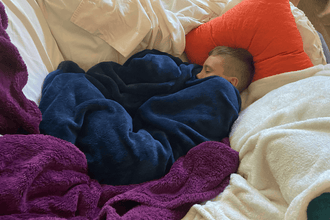
What is a sensory swing?
TABLE OF CONTENTS
- What is a sensory swing?
- Benefits of Sensory Swing
- Types of Outree Sensory Swing
-
Are sensory swings only for children with special needs?
- Where Can You Hang a Sensory Swing?
- How to Choose the Right Sensory Swing?
- Conclusion
A sensory swing is a fun and cozy space that helps children relax, focus, and develop sensory skills.While originally designed for kids with special needs, any child can enjoy its soothing motion and playful experience. This article will introduce the different types of sensory swings, their benefits, where to hang them, and tips for choosing the right one—helping you find the perfect swing to create a safe, fun, and enriching space for your child.
What is a sensory swing?
The Sensory Swing is a specially designed swing for children with special needs, intended to create a safe and comforting space. Its unique design resembles a warm blanket, allowing children to experience soothing sensations as they swing back and forth, helping to calm emotions and effectively block out unnecessary sensory stimuli.
Benefits of Sensory Swing
-
Calms and soothes: Gentle swinging provides a cozy, comforting space that helps reduce anxiety and stress.
-
Boosts sensory development: Supports balance, coordination, and integration of sensory input.
-
Improves focus: Vestibular stimulation can help children concentrate better.
-
Encourages physical activity: Strengthens core muscles and improves motor skills.
-
Offers a safe retreat: A private, calming space for self-regulation and relaxation.
Types of Outree Sensory Swing
Outree Double Layer Sensory Swing:Designed with two layers of soft, durable fabric for extra comfort and better support, perfect for creating a cozy sensory space.
Outree Single Layer Sensory Swing:Lightweight and breathable, this soft swing offers gentle pressure and calming motion—perfect for relaxation, focus, and fun.
Outree Sensory Pod Swing for Kids:Pod swing offers a snug, secure feeling—ideal for helping children relax, read, or play.
Outree Light Up Kids Sensory Swing:With 16 colors and fun flashing modes, this glowing swing turns every playtime into a magical light show!
Outree Sensory Swing with Fiber Optic Light:Experience soothing motion and magical lighting with fiber-optic illumination, creating a calming sensory retreat perfect for play or relaxation.
Are sensory swings only for children with special needs?
No,while they’re often recommended for kids with autism, ADHD, or sensory processing challenges due to their calming and regulating effects, many typically developing children benefit as well.
Just like exercise is good for everyone, sensory input is a basic human need. These swings provide rhythmic, soothing motion that can help:
-
Students unwind and regulate emotions after a long school day
-
Active kids seeking sensory stimulation and fun
-
Families looking for cozy, engaging home activities
-
Toddlers and preschoolers developing motor skills and body awareness
-
Siblings or friends who want a shared, fun, interactive activity
-
Home learners needing movement breaks to stay focused
Think of a sensory swing less as a therapeutic tool and more as a proactive wellness activity—like yoga for kids. Every child and family can benefit from a little extra sensory support to navigate their world with joy and balance.
Where Can You Hang a Sensory Swing?
Many people aren’t sure where to install a sensory swing. In this part, we’ll give some simple tips on safe and fun spots—indoors or outdoors—so your child can enjoy it comfortably.
Ceiling:
The ceiling is the most basic and common option, and our swings come with all the necessary hardware to make installation easy and secure.
Frame:
You can also hang the swing on a sturdy frame, making it easy to set up indoors or outdoors without drilling into the ceiling
Gazebo Beam:
A gazebo beam at home can also be an excellent place for setting up the swing.
Tree Branch:
You might not expect it, but a solid tree branch works great as a swing mount too!
How to Choose the Right Sensory Swing
Age
-
Pod Swing: Mainly recommended for younger children. Easier to use and provides a cozy, full-body wrap.
-
Sensory Swing: Recommended for older children. Offers more challenging sensory experiences.
Material & Comfort
-
Choose soft, breathable, and durable materials, such as high-density cotton, nylon, or polyester.
-
For children with sensitive skin, avoid rough or potentially allergenic materials.
Safety
-
Ensure the swing has sturdy hooks or support systems.
-
Features should include non-slip design and strong stitching.
-
When used indoors, leave enough surrounding space to avoid collisions.
Purpose / Use
-
Sensory Pod Swing: Offers a full-body wrapping sensation, suitable for children who need deep pressure stimulation, helping to relieve anxiety or hyperactivity.
-
Light Up Sensory Swing & Sensory Swing with Fiber Optic Light: Combine visual stimulation, ideal for a multi-sensory experience.
-
Single Layer Swing: Provides simple swinging, suitable for general entertainment or balance training.
-
Double Layer Swing : Can provide multiple sensory stimuli at once, such as swinging, wrapping, and suspension.
Conclusion
Sensory swings offer children comfort, fun, and sensory development. Choosing the right type based on age, weight, and needs ensures safety and maximum benefit, making them a valuable addition to any home or play area.













